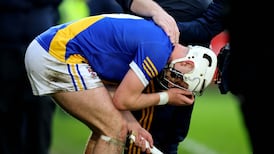Equality is at the essence of the latest effort to amalgamate the two women’s Gaelic games organisations with the GAA, the Gaelic Players’ Association (GPA) looking to crystallise opinion on that matter with their motion at Congress this weekend.
GPA chief executive Tom Parsons outlined that exact intention at a press briefing at the Radisson Hotel in Dublin Airport on Monday, highlighting the fact the biggest push is coming from the players themselves, and that the time for integration is "here and now".
Motion 33 calls on the association “to prioritise integration with the LGFA and Camogie Association in order to jointly ensure equal recognition, investment and opportunity for all genders to play all sports in the Gaelic games family”.
For Parsons, the former Mayo footballer, there’s already been enough talk on the matter, now is the time for action.
“There’s been a journey for the three separate governing bodies for 20 years now,” he said, “even going back to 2003 when Seán Kelly set up a working group to bring them all together as one GAA family, by the end of 2007.
“Since then all we’ve seen are memorandums of understanding, agreement to make stronger links, but we’ve never got a commitment. That’s what players are shouting for now, a commitment and timeline, because equality cannot be achieved as long as there are three separate organisations.
“The motion is about integration, but also to ensure equal opportunity for every GAA player, girl or boy, man or woman. Morally and culturally it’s the right thing to do, but it also creates great opportunities, to further propel the GAA as one of the greatest sporting organisations in the world. The one thing that’s holding the GAA back is that it represents boys and men only.”
As for barriers which to date may have prevented such a move, Parsons believes fear of losing some “voice” may be chief among them: “There might be the fear of losing an independent voice, or would there be equal investment and recognition. There’s a responsibility for the GAA to ensure this is a win-win for all three associations, same as when the GPA merged with the LGPA [last year]. Since we merged the women’s voice has only been strengthened.
“It’s about making the commitment to equality, and equal representation, and that’s now Government policy, released by Sport Ireland, that every boardroom and committee needs to have at least 40 per cent gender balance by 2023.
“There is huge opportunity for the GAA as well, some of the most successful organisations in the world have succeeded because they embraced gender diversity. Even commercially, organisations won’t want to sponsor male-only competition, or female-only competition, they’ll want to see gender balance, see that diversity.”
Stories abound of the women’s games repeatedly taking a backseat to the men’s, particularly when it comes to venues, in some intercounty cases the men’s facilities required payment.
“Imagine a world where all the GAA infrastructure was equally available,” said Parsons. “We’ve heard too many stories where senior women’s team didn’t only play second class to senior men, but under-20 and minor cases in some cases. The only way to ensure that equality is to fully integrate and share the resources and facilities, coaches and development.”
A recent poll of the GPA body of intercounty players showed 97 cent agreement on integration (with a 100 per cent response).
“From a players’ point of view, we’ve done everything within out control to ensure equality, from all out sub-committees, boards, is 50-50 gender balanced, we’ve equal funding now, all commercial activity has a male-female element, that’s not negotiable. The next step is somewhat outside of our control, but we’d like to influence the three governing bodies to take ownership of something that is so important.”
Parsons was confident the motion would succeed: "We'd be significantly disappointed if it wasn't passed. But from the sentiments of Tom Ryan, in his annual report, integration is the way forward, the appetite is there, so I would be surprised if we didn't get that unanimous support on the floor.
“And to alleviate any concerns, the immediate ask we would have is there’s a joint-commitment statement, post-Congress, that would be a huge success. If we get a joint-commitment in 2022, the vision after that is to achieve equality in the next year to 18 months. We don’t have 10 years to wait for equality, we have the here and now.”
The practical benefits of amalgamation were seen in the GPA when last May women were allocated the same Government grants to intercounty players as men receive.
Tyrone footballer Conor Meyler also lent his voice in support of the motion, saying: "This merger would be beneficial for both sides, not a case of a woman's gain is a man's loss, it's not that at all. It's a gain for everybody.
“I think there’s also a lack of awareness in the GAA, and intercounty players, don’t maybe understand what’s going on. We also need a lot more men to step up and ask questions about equality, saying what’s not acceptable, things I’ve never had to deal with as a male player.”












